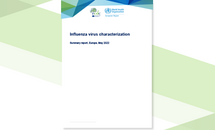Influenza virus characterisation, Summary Europe, April 2019
This is the sixth report for the 2018–19 influenza season. As of week 18/2019, 203 585 influenza detections across the WHO European Region had been reported. Detections were 99% type A viruses, with A(H1N1)pdm09 prevailing over A(H3N2), and 1% type B viruses, with 80 (65%) of 124 ascribed to a lineage being B/Yamagata-lineage.
Executive Summary
Since the March 2019 characterisation report1, a further shipment of influenza-positive specimens from an EU/EEA country was received at the London WHO CC, the Francis Crick Worldwide Influenza Centre (WIC). A total of 1 057 virus specimens, with collection dates after 31 August 2018, have been received.
All 59 A(H1N1)pdm09 test viruses characterised antigenically since the March 2019 characterisation report showed good reactivity with antiserum raised against the 2018–19 vaccine virus, A/Michigan/45/2015 (clade 6B.1). The 391 test viruses with collection dates from week 40/2018 genetically characterised at the WIC, including an H1N2 reassortant, all fell in a 6B.1 subclade, designated 6B.1A, defined by HA1 amino acid substitutions of S74R, S164T and I295V. Of these recently circulating viruses, 355 also have HA1 S183P substitution, often with additional substitutions in HA1 and/or HA2.
Since the last report, only 26 A(H3N2) viruses successfully recovered had sufficient HA titre to allow antigenic characterisation by HI assay in the presence of oseltamivir. These viruses were poorly recognised by antisera raised against the currently used vaccine virus, egg-propagated A/Singapore/INFIMH-16-0019/2016, in HI assays. Of the 321 viruses with collection dates from week 40/2018 genetically characterised at the WIC, 267 were clade 3C.2a (with 32 3C.2a2, 13 3C.2a3, six 3C.2a4 and 216 3C.2a1b) and 54 were clade 3C.3a.
No B/Victoria-lineage viruses were characterised in this reporting period. All recent viruses carry HA genes that fall in clade 1A but encode HA1 amino acid substitutions of I117V, N129D and V146I compared to a previous vaccine virus, B/Brisbane/60/2008. Groups of viruses defined by deletions of two (Δ162-163, 1A(Δ2)) or three (Δ162-164, 1A(Δ3)) amino acids in HA1 have emerged, with the triple deletion group having subgroups of Asian and African origin. HI analyses with panels of post-infection ferret antisera have shown these virus groups to be antigenically distinguishable. Of a total of five viruses characterised from EU/EEA countries this season, one has been Δ162-163 and four Δ162-164 (three African and one Asian subgroup).
Including the two B/Yamagata-lineage viruses reported on here, a total of 11 from the 2018–19 season have been characterised. All have HA genes that fall in clade 3 and encode HA1 amino acid substitutions of L172Q and M251V compared to the vaccine virus B/Phuket/3073/2013 but remain antigenically similar to the vaccine virus recommended for use in quadrivalent vaccines for current and subsequent northern hemisphere influenza seasons.
Download





